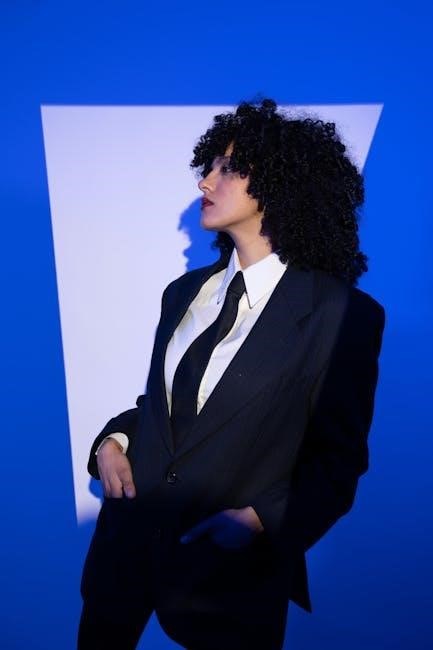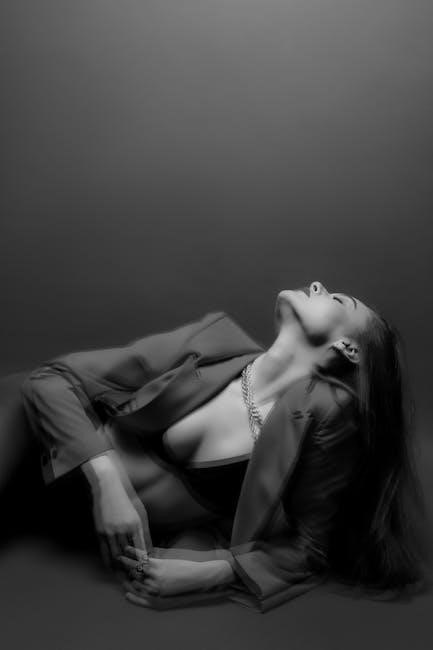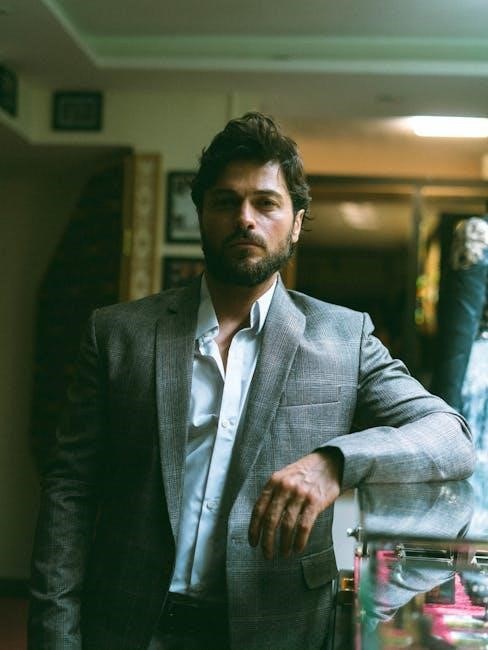The zoot suit, a stylized suit popularized in the 1930s-1940s, became a cultural symbol of identity and resistance, especially among African American and Latino youth, blending fashion and defiance.
1.1 Definition and Historical Context
The zoot suit, a flamboyant, oversized suit with padded shoulders and tapered pants, emerged in the 1930s-1940s among African American and Latino youth. It symbolized rebellion, cultural pride, and resistance to societal norms, becoming a defining element of urban fashion during World War II. The suit’s exaggerated style reflected a mix of fashion innovation and social defiance, marking its place in historical and cultural narratives.
1.2 Cultural Significance of the Zoot Suit
The zoot suit became a powerful cultural symbol, representing identity, rebellion, and resistance. It transcended fashion, embodying the struggles and pride of marginalized communities, particularly during the 1940s. The suit’s bold style challenged societal norms, making it a focal point in social and political movements. Its influence extended beyond clothing, becoming a beacon of cultural expression and unity for those seeking to assert their presence in a divided world.
Origin and Evolution of the Zoot Suit
The zoot suit originated in the 1930s among African American and Latino youth, featuring exaggerated styles with broad shoulders and tapered pants. It evolved into a symbol of rebellion and identity by the 1940s.
2.1 Early 20th-Century Fashion Influences
The zoot suit emerged in the 1930s, influenced by 1920s fashion trends like wide lapels and longer jackets. It evolved into a bold, exaggerated style with broad shoulders and tapered pants. Tailored to perfection, it became a symbol of rebellion and cultural identity, reflecting the fusion of African American and Latino fashion influences of the early 20th century, empowering youth with a unique expression.
2.2 The Role of the Zoot Suit in 1940s Subcultures
The zoot suit became a defining symbol of 1940s subcultures, particularly among Latino and African American youth. It represented rebellion, nonconformity, and cultural pride, empowering marginalized groups to express their identity. The exaggerated style, with its wide shoulders and tapered pants, challenged mainstream fashion norms, fostering a sense of community and defiance among wearers during a time of social and racial tension.
The Zoot Suit Riots and Their Impact
The 1943 Zoot Suit Riots in Los Angeles escalated racial tensions, as servicemen targeted Mexican-American youths wearing zoot suits, symbolizing cultural resistance and sparking widespread social unrest.
3.1 Historical Background of the Zoot Suit Riots
The Zoot Suit Riots erupted in Los Angeles in 1943, fueled by racial tensions during WWII. Mexican-American youths wearing zoot suits, seen as symbols of defiance, were targeted by servicemen. The riots reflected deep-seated economic and social tensions, as well as anti-Mexican sentiment. Media sensationalism exacerbated the conflict, leading to widespread violence and highlighting racial divisions in wartime America.
3.2 Social and Political Consequences of the Riots
The Zoot Suit Riots exposed deep racial and social tensions, leading to increased discrimination against minority groups. They sparked political debates about equality and justice, prompting some policy changes. The riots also galvanized activism, inspiring movements for civil rights and challenging systemic racism. The aftermath highlighted the need for cultural understanding and legal reforms to address racial profiling and violence.
The Zoot Suit in Modern Fashion
The zoot suit has seen a modern resurgence, inspiring contemporary designers with its bold, oversized silhouette and cultural significance, blending nostalgia with fresh, innovative styles and materials.
4.1 Revival of the Zoot Suit in Contemporary Design
The zoot suit has re-emerged in contemporary fashion, with designers incorporating its iconic oversized jacket and tapered trousers into modern collections. This revival blends historical flair with innovative fabrics and styling, reflecting a nostalgia for rebellious 1940s fashion while catering to today’s diverse tastes and cultural expressions, making it a timeless yet evolving fashion statement.
4.2 Influence on Modern Subcultures and Fashion Trends
The zoot suit’s bold style has inspired modern subcultures, influencing punk, hip-hop, and streetwear. Its exaggerated silhouette and rebellious roots appeal to contemporary designers, blending vintage flair with modern aesthetics. Fashion brands often reinterpret the zoot suit, creating a bridge between historical rebellion and today’s fashion trends, ensuring its cultural significance endures across generations and diverse styles.

The Zoot Suit in Popular Culture
The zoot suit’s flamboyant design and rebellious roots have made it a cultural icon, symbolizing identity and resistance in films, music, and art, enduring as a timeless fashion statement.
5.1 Depiction in Movies, Music, and Literature
The zoot suit’s vibrant style and rebellious connotations have captivated filmmakers, musicians, and authors. In films like Zoot Suit, it symbolizes cultural pride and defiance. In music, artists evoke its flair to express individuality. Literature often portrays it as a metaphor for resistance, blending fashion with social commentary, ensuring its legacy endures across various artistic mediums and cultural narratives.
5.2 The Zoot Suit as a Symbol of Rebellion
The zoot suit became a powerful emblem of rebellion, particularly during the 1940s. Its exaggerated style defied conventional norms, symbolizing resistance against societal expectations and racial discrimination. Worn by marginalized groups, it represented a bold statement of identity and defiance, transcending fashion to embody a cultural and political stance that continues to inspire contemporary movements and artistic expressions of nonconformity.
How to Create a Zoot Suit PDF
Design a zoot suit pattern, include historical context, cultural significance, and sewing tips. Compile into a structured PDF for easy reference and sharing fashion enthusiasts.
6.1 Designing a Zoot Suit Pattern
Creating a zoot suit pattern involves drafting a loose-fitting jacket with exaggerated shoulders, a tapered waist, and matching high-waisted, wide-legged trousers. Use measurements to ensure a tailored fit while maintaining the zoot suit’s signature oversized silhouette. Incorporate detailed annotations for fabric selection, seam allowances, and styling elements to guide the sewing process effectively.
6.2 Sewing and Tailoring Tips
When sewing a zoot suit, use high-quality, heavy fabrics like wool or linen for structure. Staystitch seams to maintain shape and press thoroughly for crisp lines. Fit the jacket and trousers separately, ensuring a snug waist. Use a muslin prototype to perfect the fit. Incorporate padding in shoulders for definition and wide lapels for authenticity. Attention to detail ensures a professional finish.

Legal and Social Impact of the Zoot Suit
The zoot suit’s exaggerated style sparked legal debates and social unrest, becoming a symbol of rebellion and cultural identity, while fueling racial tensions during the 1940s riots.
7.1 The Zoot Suit as a Symbol of Identity
The zoot suit emerged as a powerful emblem of cultural identity, particularly for Latino and African American youth, expressing defiance against societal norms and economic hardships. Its exaggerated design signified pride and resistance, transcending fashion to represent a collective stance against marginalization during the 1940s.
7.2 Racial and Ethnic Tensions Associated with the Zoot Suit
The zoot suit became a focal point of racial and ethnic tensions, particularly during the 1940s. Its association with Latino and African American youth led to clashes with authority figures and other groups, fueling stereotypes and discrimination. The style’s defiance of mainstream norms exacerbated existing prejudices, making it a symbol of resistance and a target of racial hostility during a time of societal unrest.

The Zoot Suit in Art and Photography
The zoot suit’s bold design and cultural significance have inspired artists and photographers, capturing its rebellious spirit and historical importance through iconic imagery and creative interpretations.
8.1 Iconic Images of the Zoot Suit
Iconic images of the zoot suit, captured by photographers like Gordon Parks, highlight its cultural significance, showcasing bold styles and the confidence of wearers. These photographs, often featured in historical exhibitions, emphasize the suit’s oversized silhouette, padded shoulders, and tapered pants, symbolizing rebellion and identity. The visuals have become timeless representations of 1940s fashion and social expression, preserving the zoot suit’s legacy in art and history.
8.2 The Zoot Suit as a Subject in Art
The zoot suit has inspired numerous artistic interpretations, from paintings to sculptures, celebrating its cultural and historical significance. Artists often depict the suit in vibrant colors, emphasizing its exaggerated features. These works reflect the suit’s role in identity formation and its connection to social movements. By immortalizing the zoot suit in art, creators honor its enduring influence on fashion and societal expression, ensuring its legacy endures through creative mediums.

The Zoot Suit in Historical Preservation
Museums worldwide showcase zoot suits in exhibits, preserving their cultural legacy. Educational programs highlight their historical significance, ensuring future generations understand their impact on fashion and identity.
9.1 Museums and Exhibitions Featuring the Zoot Suit
Museums like the Smithsonian and the Museum of Contemporary Art have showcased zoot suits in exhibitions, highlighting their cultural and historical significance. These displays often feature photographs, films, and artifacts that trace the zoot suit’s evolution and its role in identity politics. Exhibitions educate visitors about the suit’s impact on fashion, race, and social movements, preserving its legacy for future generations to explore and understand.
9.2 Efforts to Preserve the Cultural Legacy of the Zoot Suit
Organizations and historians are working to preserve the zoot suit’s cultural significance through educational programs, digital archives, and collaborations with artists. These efforts aim to educate future generations about its role in identity, resistance, and fashion history, ensuring its legacy endures as a symbol of cultural resilience and creativity.

The Zoot Suit in Music and Dance
The zoot suit’s flashy style influenced music and dance, becoming a symbol of performance flair and cultural identity, inspiring artists to embrace its rebellious spirit in their work.
10.1 The Zoot Suit’s Influence on Music Genres
The zoot suit’s bold style influenced various music genres, from jazz and swing to Latin and hip-hop. Its flamboyant design became a symbol of rebellion and cultural identity, resonating with musicians who used fashion to express their artistry and connect with their audiences, blending music and fashion into a powerful statement of unity and defiance.
10.2 The Zoot Suit in Dance Culture
The zoot suit’s flamboyant style deeply influenced dance culture, particularly in swing and Latin dance scenes. Its exaggerated silhouette and vibrant fabrics mirrored the energetic and rebellious spirit of the dances, becoming a visual expression of cultural identity. Dancers often wore zoot suits to showcase their moves, blending fashion with rhythm and creating a lasting impact on the visual language of dance.

The Zoot Suit in Politics and Activism
The zoot suit emerged as a powerful political symbol, representing resistance and cultural identity among marginalized communities, challenging societal norms and authority through its bold style, inspiring activists in social movements.
11.1 The Zoot Suit as a Political Statement
The zoot suit became a bold political statement, symbolizing resistance against discrimination and oppression. It was worn by marginalized groups to assert their identity and challenge societal norms, embodying defiance and cultural pride. The exaggerated style and tailored fit signified a rejection of mainstream values, making it a powerful visual expression of social and political dissent during its era.
11.2 The Role of the Zoot Suit in Social Movements
The zoot suit played a significant role in social movements, particularly among minority youth during the 1940s. It became a unifying symbol of solidarity and resistance, reflecting the struggles of racial and ethnic communities. The suit’s flamboyant design challenged societal norms, making it a powerful tool for expressing dissent and fostering unity among those fighting for civil rights and social justice.
The Zoot Suit in Literature and Poetry
The zoot suit often appears in literature and poetry as a symbol of rebellion and cultural identity, reflecting its historical significance in marginalized communities’ struggles and expressions.
12.1 The Zoot Suit as a Literary Symbol
The zoot suit is a powerful literary symbol, often representing rebellion, cultural identity, and resistance. It features prominently in works exploring marginalized communities, embodying their struggles and pride. Authors use the suit to highlight societal tensions and the resilience of those who wear it, making it a vivid metaphor for individuality and collective identity.
12.2 Poetry Inspired by the Zoot Suit
Poetry inspired by the zoot suit often captures its cultural and symbolic essence, reflecting themes of rebellion, identity, and resilience. The suit’s exaggerated style and historical context, including the riots, inspire vivid imagery and metaphors. Poets use the zoot suit to explore racial tensions, youthful defiance, and the struggle for self-expression, making it a rich subject in literary works.
The Zoot Suit in Contemporary Media
The zoot suit appears in modern films, TV series, and video games, often symbolizing rebellion and cultural identity, while its iconic design continues to inspire visual narratives and character aesthetics.
13.1 The Zoot Suit in Modern Film and Television
The zoot suit continues to captivate modern audiences in films and TV series, often symbolizing rebellion and cultural identity. Its distinctive style is featured in productions like Zoot Suit (1981) and The Mask (1994), highlighting its visual impact and historical significance. The suit’s flair for drama and nonconformity makes it a popular choice for directors aiming to evoke nostalgia or underline subcultural themes in contemporary storytelling.
13.2 The Zoot Suit in Video Games and Digital Media
The zoot suit has appeared in various video games, such as L.A. Noire and Mafia II, where it reflects 1940s fashion and cultural identity. In digital media, its iconic design is often used in character customization, adding a touch of retro rebellion. The suit’s stylistic appeal also inspires virtual fashion, blending historical authenticity with modern creativity, ensuring its legacy endures in the digital realm.
The zoot suit remains a powerful cultural symbol, blending style with rebellion. Its enduring influence spans fashion, media, and social movements, ensuring its legacy as a timeless icon of identity and expression.
14.1 The Enduring Legacy of the Zoot Suit
The zoot suit’s legacy endures as a cultural icon, symbolizing rebellion and identity. Originating in the 1940s, it remains a powerful representation of marginalized communities’ resistance and self-expression, influencing fashion, art, and social movements. Its bold design and historical significance continue to inspire contemporary culture, ensuring its place as a timeless symbol of defiance and cultural pride.
14.2 The Future of the Zoot Suit in Fashion and Culture
The zoot suit’s future lies in its adaptation to modern fashion while retaining its cultural essence. Designers are reimagining the suit with contemporary fabrics and styles, appealing to new generations. Its influence on streetwear and luxury fashion continues to grow, blending rebellion with sophistication. As a cultural symbol, the zoot suit remains a powerful emblem of identity and resilience, ensuring its relevance in both fashion and social discourse.
